Article and photos by Joe Sapia
Note: The yard references are to my house in the section of Monroe between Helmetta and Jamesburg in South Middlesex County. My yard is in a Pine Barrens outlier on the Inner Coastal Plain, the soil is loamy, and my neighborhood is on the boundary of Gardening Zones 6b (cooler) and 7a (warmer). Afield references are to the Pine Barrens around Helmetta, unless otherwise noted. Notes and photographs are for the period covered, unless otherwise noted.
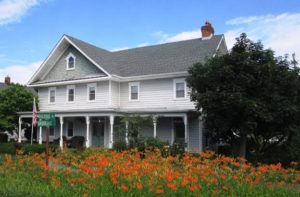
Daylilies flower in front of the former Avon Inn in Helmetta.
FLOWERING OF HELMETTA’S AVON INN: The former Avon Inn in Helmetta comes to flowering life this time of year. Now a private residence, it dates back as a circa late 1800s-early 1900s inn positioned near a railroad station. (Think of the hotel on the 1963-1970 television sitcom “Petticoat Junction.”) The Avon Inn sits at on the corner of Railroad Avenue and Brookside Place (or across from the Helmetta Post Office). It is part of the George W. Helme Snuff Mill District, named to the state and federal Registers of Historic Places in 1980.
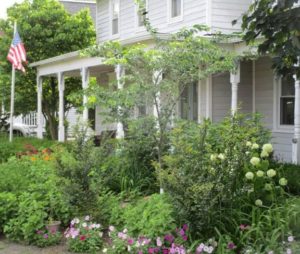
Another view of the former Avon Inn.
“OUTHOUSE LILIES”: Wild daylilies are blooming along roadsides. As their Greek scientific name “Hemerocallis fulva” suggests, “Day beauty” and “tawny” in color. Beautiful? Yes. A weed? Yes. They threaten native plants and are hard to control. It is an Asian species now naturalized locally. It was introduced to the United States as an ornamental, according to the National Park Service. In the days of outhouses, people planted daylilies around them. (Today’s ornamental daylilies began blooming earlier.)
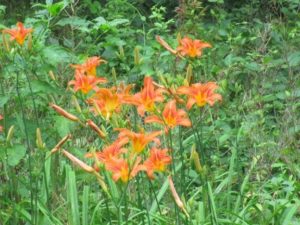
Wild daylilies growing on North Main Street in Cranbury, Middlesex County.
FRAGRANT WATER LILIES ON HELMETTA POND: At this time of year, a floral display explodes on Helmetta Pond. Fragrant water lilies, “Nymphaea odorata,” simply dot the Pond. The flower, which blooms from about June to September, is beautiful. It has a multitude of white (or pinkish) petals and a sunflower-looking yellow stigmatic bowl. The blossom has a fresh and flowery scent. Also in bloom at the Pond is pickerel weed, “”Pontederia cordata.”
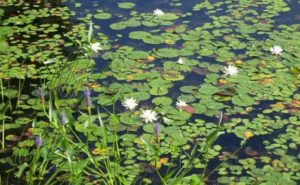
White-colored fragrant water lilies and purple-colored pickerel weed at Helmetta Pond.
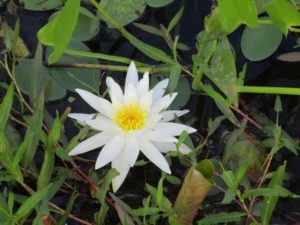
A close-up of a fragrant water lily at Helmetta Pond.
AMPHIBIANS AND REPTILES: I helped a painted turtle, “Chrysemys picta picta,” as it was crossing a road at the Helmetta Pond swamp. I moved the painter in the direction it was traveling. When I got home after moving the turtle, I did yardwork and came across Fowler’s toads, “Anaxyrus fowleri.”
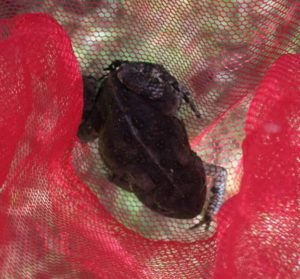
I netted this Fowler’s toad in my yard to study him for a few seconds.
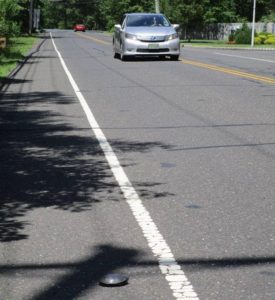
A painted turtle crossing a road at the Helmetta Pond wetlands. As I was shooting the photograph to give perspective on traffic, the car pulled over. The driver was neighbor and Garden and Afield reader Tom DeRose.
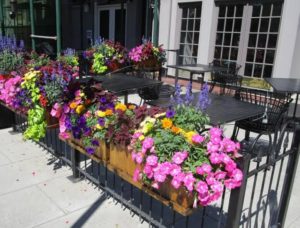
Flower display at Catherine Lombardi restaurant in New Brunswick, Middlesex County.
FLOWERING NEW BRUNSWICK: I work part-time at the Jules and Jane Plangere Writing Center on the College Avenue campus of Rutgers University in New Brunswick, Middlesex County. Because I park my Jeep at the other side of the downtown near the Douglass campus, I often walk cross-town to and from Plangere. This time of year, I pass flowers beautifully on display at the Catherine Lombardi restaurant at the corner of Livingston Avenue and George Street.
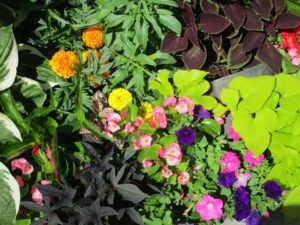
Flower display at Catherine Lombardi restaurant.
GOLDFINCH IN PEPPY’S GARDEN: Gardener Priscilla “Peppy” Bath of Hamilton, Mercer County, reported, “Saw something interesting the other day. I have columbine plants in the yard that seed themselves so they are easy to grow. I cut some of the high stems with seed when I get around to it. I saw a goldfinch (“Spinus tristis”) holding on to the main stem and eating the seeds. I did not think the stem would be strong enough but guess the bird does not weigh much. Nice. Glad I did not cut all the seeds from all the plants.”
IN THE GARDEN: A shout out to Lake Valley Seed’s “Salad Bowl Heirloom Lettuce.” I planted it April 8 and have been harvesting it in earnest – and getting rave reviews from people I have given it to. I, too, offer a positive review. On the down side, my snap peas bombed and my kaleidoscope carrots are growing slowly; Both were planted April 8. In summary, I continue to water, weed, and watch, along with harvesting the lettuce.
IN THE PINE BARRENS AROUND HELMETTA: Striped wintergreen, “Chimaphila maculate,” is in bud. Also, this is the time of year, the woods are lush and humid with pine flies, genus “Chrysops,” buzzing around a person in numbers. Because of the harsh conditions in the woods this time of year, I would shut down my woods walking – and that was probably why I recall seeing striped wintergreen in full bloom perhaps only once in my life. But, in recent years, I have taken a new approach – or, actually, an old approach dating back to childhood – and that is tough it out and enjoy the summer woods, along with the woods during the other three seasons.
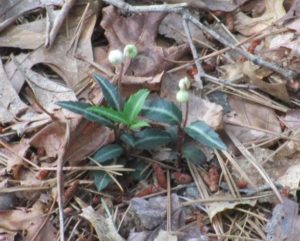
Striped wintergreen in bud in the Jamesburg Park section of East Brunswick, Middlesex County.
RAINBOW AND SUNSET: The night of Monday, June 19, provided a beautiful sky at sunset – in the sunset itself and with a rainbow. I watched it all from my yard.
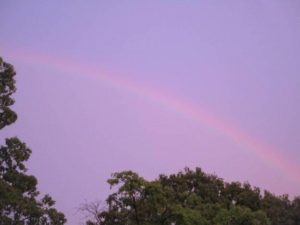
Looking east, the June 19 rainbow over the Manalapan Brook floodplain.
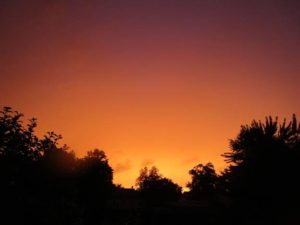
The June 19 sunset.
SUNRISE/SUNSET: For June 25, Sunday, to July 1, Saturday, the sun will rise at about 5:25 a.m. and set about 8:30 p.m.
WEATHER: The National Weather Service forecasting station for the area is at http://www.weather.gov/phi/.
THE DESTRUCTION OF THE MIDLANDS: As much as environmental conditions have improved in many ways in my lifetime, something we have not kept up with is preservation of open space. When I see the destruction of open space, especially when heavy machinery mows down the woods in only hours, I feel sad. I drove by a site the other day in South Brunswick, Middlesex County, where the woods was being torn down.
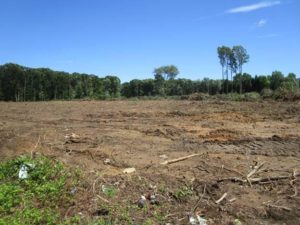
The corner of Route 130 and Fresh Ponds Road was woods only a few days ago.
Joe Sapia, 60, is a lifelong Monroe resident. He is a Pine Barrens naturalist and an organic vegetable-fruit gardener. He gardens the same backyard plot as did his Italian-American father, Joe Sr., and his Polish-immigrant, maternal grandmother, Annie Poznanski Onda. Both are inspirations for his food gardening. Joe is active with the Rutgers University Master Gardeners/Middlesex County program.
He draws inspiration on the Pine Barrens around Helmetta from his mother, Sophie Onda Sapia, who lived her whole life in these Pines, and his Grandma Annie. Joe’s work also is at @JosephSapia on Twitter.com, along with Facebook.com on the Jersey Midlands page.
Message and photos by Jamie Bruno.
Editor’s Note: The LRWP and coLAB arts are pleased to welcome Jamie Bruno to our work in New Brunswick. Jamie will join us for the next 9 months as our National Endowment for the Arts Resident Artist.

Hello Dear Reader. Happy to be writing to you today.
As the new Resident Artist with the Lower Raritan Watershed Partnership my work is to bring people to the river and bring the river to people. Increasing that knowledge and access increases people’s value of a healthy river and watershed. Much of my work will be dedicated to CoLAB Arts and LRWP’s existing programming such as Rail-Arts-River and Trash Troubadour, within which the already incredible experience of cleaning up a stream also becomes an experience in arts and culture.
I live in Newark, NJ. My most recent work has been focused around urban agriculture, food security, food waste management, and organizing for urban agriculture alliance development. I manage a small farmers market for a local nonprofit once a week at a hospital in Newark. My most recent artwork, “And all our dead can live again,” is a functioning geodesic dome that, in many ways, is a reaction to doing urban agriculture and local food development work in a post-industrial inner city.
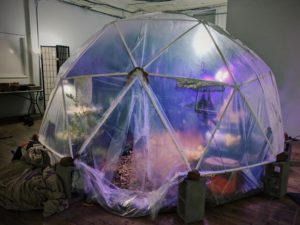
All Our Dead Can Live Again
As a graduate of Rutgers Mason Gross School of the Arts, I am already familiar with New Brunswick though I am still orienting to this new position and a changed city. My eyes see the river differently from the scientists, geologists and academics who study it. Slowly I will see more. For now I notice the strange interactions between humans and the human built riverfront. On my first trip re-visiting Boyd Park I see moments of departure in the landscape by an uncooperative nature, consistently unconcerned with our good intentions. And neglect by us, to simply sit and listen to her. I can’t wait to tell you more about that visit.
You don’t know me and I will only be with you, officially, for a short nine months. But within that nine months I hope that we can make sweet, passionate earth caring goodness together. Earth Care. People care. Future care. In the incredibly succinct lyrics of M.I.A.’s song “Meds and Feds”: We just “give a damn,” and, another inspiration, Y.A.L.A. (You Always Live Again as opposed to the formerly popular phrase, Y.O.L.O., You Only Live Once)… Earth karma.
Thank you for reading. If you’d like to see more of my work please visit tothedirt.net
Article and photos by Joe Mish
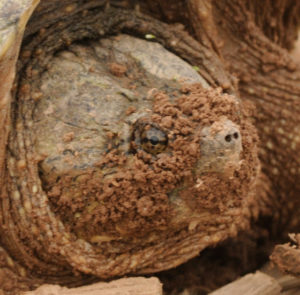
A snapping turtle mom in the process of laying eggs, remains motionless for hours, her body rising up as each egg is laid in the nest. Soil covers her face as a result of excavating a nest hole in which she will lay, according to several sources, 20 to 40 eggs.
I have always been fascinated with turtles, most likely because they were such strange animals, so different from anything else. They wore their skeleton on the outside, so in a way, they never left home even when they traveled. I learned the top shell was a carapace and the lower shell was a called a plastron. For a kid, way back when, to toss those words around, made people take notice and think the kid must be a budding genius. When asked, “what do you want to be when you grow up?” The answer was a quick, “I want to be a herpetologist!”, immediately followed by, “What’s a herpetologist?”.
A small book, A Golden Guide, Reptiles and Amphibians, was my constant companion. I studied the turtle section and noted the distribution of each species as shown in pink on a profile map of the USA. I was used to seeing painted turtles, musk turtles and snapping turtles when I went fishing, and box turtles a-plenty crossing roads on the way to the shore. There was an area in the nearby clay banks where slow flowing streams and spring fed ponds that drained into the river were overrun with spotted turtles.

A musk turtle sunning high above the water. Often when canoeing, a large splash of a musk turtle diving off a high branch causes a moment of mystery.
On occasion an uncommon turtle would cross my path. It was these rarely seen animals that really drew me in. There were wood turtles, Muhlenberg/Bog turtles and even a diamondback terrapin caught in a box style crab trap in Raritan Bay. These turtles being royalty; given their limited distribution.
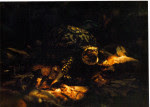
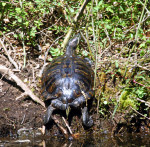
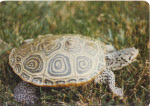
From top to bottom: A terrapin, red slider and eastern box turtles are a few of the turtle species found in NJ. Sliders and map turtles are working their way north via the Delaware Raritan canal.
As I got to know turtles and realized how long they live and how vulnerable they can be, I felt a kinship of sorts and became a guardian of these gentle creatures. When summer is about nigh, especially the first couple weeks of June, turtles are often seen crossing roads to traditional nesting grounds where the female will lay a batch of white leathery eggs in a hole she digs with her hind feet. This is when female turtles are most vulnerable to being crushed on the roadways. I stay alert to avoid adding to the carnage and will help a turtle cross a road in the direction she is headed, when I can safely do so.
Considering some females may not reach maturity for 8 to 10 years, as in the case of the wood turtle, each lost female represents a devastating blow to an already threatened species.
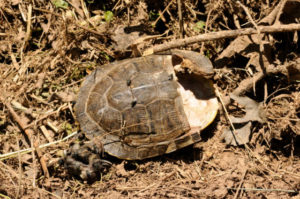
This wood turtle on her way to lay eggs was killed by a mower. Considering she was at least 10 years old the situation is even more tragic.
Turtle nests may be found hundreds of yards from any pond, river or stream. Telltale signs of a nest will be the curled fragments of the white egg cases scattered around a small hole after hatching. Otherwise you will never find a nest unless you see a turtle laying eggs or a nest dug up by a fox.
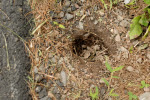
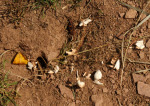
Scattered scraps of leathery turtle eggs post hatching, are often the only clue of a turtle nest. A typical turtle nest hole. This was made by a wood turtle.
I recently discovered that several map turtles have been using my yard and surrounding properties as a nesting ground. Map turtles were previously only found in southern New Jersey but have moved north primarily via the Delaware Raritan canal to the Millstone and Raritan rivers. These turtles are travelling at least 400 yards uphill through thick grass to dig nests. Imagine the journey the little guys have to survive as they follow their internal GPS back to the river.

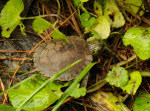
A painted turtle (top) and map turtle hatchlings make their way thru heavy grass and brush to the river.
I was fortunate to come across a snapping turtle laying eggs in a recently planted cornfield. The hours long process of laying, covering and paving over the nest by the female was captured on a GoPro camera. It is distilled down to 6 minutes and can be viewed at http://winterbearrising.wordpress.com/
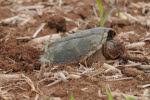
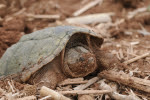
A snapping turtle lays eggs in a corn field. An hours long process where she is vulnerable to predators.
As the incubation period for most turtles can vary greatly, expect a hatch to occur from late August to September. Sometimes the hatch will not occur until the next spring. The cooler the weather during incubation period produces more males and females when weather is warmer. Across turtle species, the females reach productive maturity, in some cases, years after the males.
So be alert for nesting areas and local migrations during the nesting and hatching periods. Your yard could be a turtle nursery and you might not even know it. Be kind to our turtles and honor the legacy handed down from the Unami, a matriarchal branch of the Lenapes, known as the turtle people which inhabited this part of the state.
Author Joe Mish has been running wild in New Jersey since childhood when he found ways to escape his mother’s watchful eyes. He continues to trek the swamps, rivers and thickets seeking to share, with the residents and visitors, all of the state’s natural beauty hidden within full view. To read more of his writing and view more of his gorgeous photographs visit Winter Bear Rising, his wordpress blog. Joe’s series “Nature on the Raritan, Hidden in Plain View” runs monthly as part of the LRWP “Voices of the Watershed” series. Writing and photos used with permission from the author.
Article and photos by Joe Sapia
Note: The yard references are to my house in the section of Monroe between Helmetta and Jamesburg in South Middlesex County. My yard is in a Pine Barrens outlier on the Inner Coastal Plain, the soil is loamy, and my neighborhood is on the boundary of Gardening Zones 6b (cooler) and 7a (warmer). Afield references are to the Pine Barrens around Helmetta, unless otherwise noted. Notes and photographs are for the period covered, unless otherwise noted.
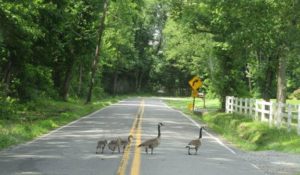
Mama and Papa Canada geese, “Branta canadensis,” and their young cross a road in the Dayton section of South Brunswick, Middlesex County, and stop my Jeep in its tracks. Silly geese! (On a serious note, humans could learn from the dedicated parenting of Canada geese.)
GOOD TO BE BACK HOME: Sorry for missing last week’s “Garden and Afield,” but I was down in New Orleans or traveling to and from. I was attending receptions for a medical residency graduation (of Dr. Anthony M. Sciascia II, the son of my college buddy) and wedding (of Anthony and Nancy). I had a wonderful time with the Sciascia clan who has treated me as family since our Marquette University days that began more than 40 years ago. But I always enjoy getting back home….
SOME N’AWLINS FLAVOR IN THE JERSEY MIDLANDS: New Orleans is known for its coffee made from the roots of chicory, “Cichorium intybus.” Well, guess what has began blooming in the Jersey Midlands? Chicory, the blue flower along roadsides and other disturbed areas. It is a foreign species naturalized here. That is, a weed. But a weed with a nice-looking flower.
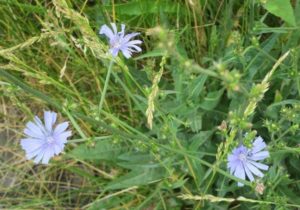
Chicory growing on a Monroe roadside.
IN THE GARDEN: While I was gone, my garden did not get its daily watering, even more critical because we had some very hot temperatures, near 100! But I began harvesting lettuce in earnest.
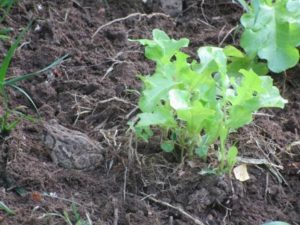
Lake Valley Seeds’s “Salad Bowl Green Heirloom Lettuce” grows in my garden. Next to the lettuce is nature’s pesticide, a toad — probably an American toad, “Anaxyrus americanus.” (Thanks to Sam Skinner, a Monmouth County Park System naturalist who set me in the right direction on the tentative identification of this toad.)
MY ORGANIC GARDEN: I just mentioned the wild toad as a natural pesticide. But, nowadays, people seem to be touchy over the term “organic,” arguing its meaning or arguing that “organic” does not mean purely natural. As I was taught in journalism, say exactly what you mean, rather than using labels. So, here is how I food garden – I add nothing to the mix except water.
MANALAPAN BROOK: The Brook flows about 400 feet from my front yard, but, thankfully, I am about 150 feet from its floodplain – so, close enough to enjoy the waterway, but far enough away not to be affected by flooding. This time of year, the Brook has a summer feel, with lush vegetation growing in the floodplain and, on this day, bright sunlight creeping through the trees. My section of the Brook is between “Jamesburg Lake” (Lake Manalapan) and “Spotswood Lake” (DeVoe Lake). Its watershed drains 40.7 square miles, according to the United States Geological Survey, in Middlesex and Monmouth Counties.
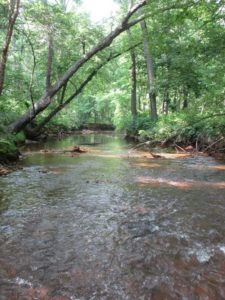
Manalapan Brook, looking downstream toward Helmetta
LIGHTNING BUGS: I saw the first lightning bug, a member of the “Lampyridae” insect family, of the season June 4. On June 17, as I was putting together this “Garden and Afield,” I watched fireflies in my backyard. There seemed to be more than normal, maybe a half-dozen to a dozen, but not the numbers I remember when I was a kid. They flash to signal mates.
ELSEWHERE IN THE YARD: Also in the yard over the last two weeks were rabbit, genus “Lepus”; the state bird, the Eastern goldfinch, “Spinus tristis,”; and my friend, the catbird, “Dumetella carolinensis.” The rabbits allow me to get within a few feet of them, probably because I go about my normal business, not TRYING to get close. The male goldfinch is brightly colored, a beautiful bird – “wild canaries” in the yard. I love catbirds. When I work in the yard or hike the Pine Barrens around Helmetta, catbirds perch nearby and keep me company.
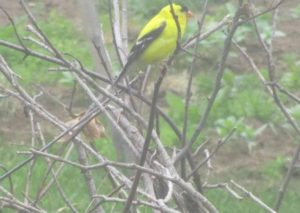
An Eastern goldfinch. Brightly colored, so it is a male.
WHITE ORCHID: Faye Bray, a friend from the Outdoor Club of South Jersey, reported a rare white variety of the pink lady-slipper orchid, “Cypripedium acaule,” in the Whitesbog, Burlington County, area of the Pine Barrens. “It’s freaking remarkable,” Faye said. (Unfortunately, we could not get a photograph for “Garden and Afield.”)
TURTLES: Turtles have been laying eggs, meaning females have been moving around. On my trip to and from New Orleans, I saw a half-dozen or so dead along the Interstate highways, apparently struck by vehicles. Up here in the Midlands, I have heard of various encounters with turtles. One, a person moved a box turtle, “Terrapene carolina,” to water. Wait, a box turtle is a land animal. Two, another person moved a snapping turtle, “Chelydra serpentina,” to a pond, possibly interrupting its egg-laying. So, my advice is, unless there is a compelling reason, leave wildlife alone. Generally, it knows what it is doing, it does not need humans to mess up its life.
TICKS: Ticks are bad this year. Essentially, they cling to vegetation and wait for a mammal to brush by them, then they attach. We have three ticks locally: deer tick, “Ixodes scapularis”; lone star tick, “Amblyomma americanum,” The female is easily distnguishable by the light-colored dot on her back; wood tick, also known as the dog tick, “Dermacentor variabilis.”
Get a tick ID pocket card. It will show the size and colors of not only these ticks, but in different stages of development. See http://www.tickencounter.org/tick_identification/guide.
There is no need to panic. Tick-borne diseases are relatively rare — I mean, if everyone in range of a tick, or even bitten by a tick, were to get sick, there would be a very sick population. However, be vigilant. In the yard, keep grass trimmed. If in the woods, take precautions by dressing properly. (If I am wearing long pants, for example, I tuck them in my socks.) And check for ticks on one’s body. When coming in from the woods or other places ticks are likely, wash the clothes and bathe as soon as possible.
If a tick is crawling on oneself, simply flick it off — It may take a few tries. If one is attached, take tweezers and grab it behind the head and pull it out. Then flush it down the toilet, throw it in a fire, or, if needed for observation, put it with an alcohol-doused cotton swab in a closed container.
If bitten, observe the bite for abnormalities, such as the Lyme Disease bull’s eye, seek medical help if concerned. The big tick disease locally is Lyme. However, New Jersey is now watching for Powassan virus.
My yard is wildlife-friendly and I take no special precautions in the yard, other than observing my clothes and body. I am always in the woods and fields, I found one tick on my body this season, but 10x or 20x that on my clothes — the point being, notice them before they get on one’s body.
Regarding the yard, keep the grass cut. I have tall-grass wildlife patches in my yard and have not found a tick on me yet while doing yardwork, etc. I would be more concerned with cats and dogs bringing them inside.
If you look them up online, use the scientific name, so as not to confuse species and colloquial names.
LETHAL ANIMALS: I would say on a daily basis, the three most lethal animals in the Pine Barens around Helmetta are the tick, mosquito, and pet dog. The former two could do a number for life, while the latter one could be hurtful for the moment.
In the Piedmont region of the Jersey Midlands, I would add copperhead snake, “Agkistrodon contortrix.” In the main Pine Barrens, the rattlesnake, “Croatus horridus.” But the chances of getting bit by either is rare.
Throughout the Midlands, a wandering black bear, “Ursus americanus,” could be a threat – but unlikely. If you see one, stay clear and that should be enough.
YOU SAY “MUSKMELON,” I SAY “MUSHMELON”: My friend Virginia Lamb, who I have turned to for advice (environmental, gardening, and general) over the years, said in reference to my using “mushmelon,” “It’s ‘muskmelon, not ‘mushmelon.’” She is correct, in a more formal sense. But I am correct, too, in a more informal way. So, I responded in an e-mail, “Local colloquialism = mushmelon. I use that only in my blog. Normally, when I talk, I say cantaloupe. (Kind of like the colloquialism “garden snake” for “garter snake.)” Yes, we are all talking cantaloupe.
SCIENTIFIC NAMES: My use of scientific names also has prompted some discussion. Sunil Nair, who has followed my Internet nature posts, said, “Love the fact that you write the genus names, too.” But Virginia Lamb noted, “Just a note on reader preference: I feel the Latin names interrupt the folksy flow of the prose and would prefer they be noted at the end. But that may just be me.” I am considering Virginia’s point. As for using scientific names, I do it so there is no question what is being discussed. “Swamp pink” could be the “Arethusa bulbosa” orchid or it could be the “Helonias bullata” lily. But a scientific name is a scientific name is a scientific name.
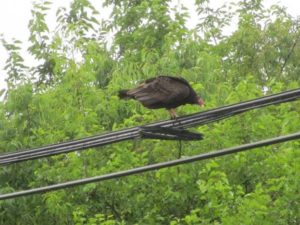
A turkey vulture, “Cathartes aura,” sits on a roadside utility line in Monroe after I spooked it when it was eating a dead ground hog, “Marmota monax.” Here, it is easily identified by its red head. Turkey vultures are commonly seen, soaring in a circle, their wings tipped into a V.
SUNRISE/SUNSET: For June 18, Sunday, to June 24, Saturday, the sun will rise between 5:25 and 5:30 a.m. and set about 8:30 p.m.
DATE TO KEEP IN MIND, JUNE 21: The longest daylight of the year is Wednesday, June 21, the summer solstice, when the sun rises at 5:28 a.m. and sets at 8:31 p.m. After June 21, daylight gets shorter.
DATE TO KEEP IN MIND, JUNE 24: St. John the Baptist Day. Sophie Majka, a neighbor who died March 8 at 92-years-old, had told me blueberries are ready to pick in the Pine Barrens around Helmetta on St. John’s Day, June 24. So, that is a target I look to.
WEATHER: The National Weather Service forecasting station for the area is at http://www.weather.gov/phi/.
SOURCES: As you can see, I have already mentioned various sources of information. Additionally, I enjoy listening to Mike McGrath’s “You Bet Your Garden” radio show on WHYY, 90.9 FM, out of Philadelphia – or on the Internet at http://whyy.org/cms/youbetyourgarden/. I also read Sally McCabe’s “In the Garden, It’s Time To…” column in the Philadelphia Inquirer newspaper, or on the Internet at philly.com.
MORE N’AWLINS FLAVOR IN HELMETTA: Why do I love traveling in the South? Maybe because I am a boy of the South – South Middlesex County. And my local roots go back to Helmetta, whose founder, for lack of a better term, George Washington Helme, was a Confederate military officer. Although a native of Kingston, Pennsylvania, Helme was a New Orleans resident during the Civil War. After the war, he came up to Helmetta, where his wife’s, Margaret Appleby Helme’s, family had a snuff mill operation – one that George would eventually take over. The George W. Helme Snuff Mill provided my family with work for approximately 75 years, from circa 1900 to 1976. The mill stopped manufacturing snuff in 1993 and, now, it is being converted into housing.
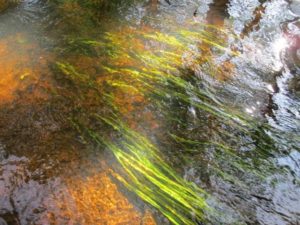
Looking into sunlit Manalapan Brook, here between Helmetta and Jamesburg.
Joe Sapia, 60, is a lifelong Monroe resident. He is a Pine Barrens naturalist and an organic vegetable-fruit gardener.
He gardens the same backyard plot as did his Italian-American father, Joe Sr., and his Polish-immigrant, maternal grandmother, Annie Poznanski Onda. Both are inspirations for his food gardening. Joe is active with the Rutgers University Master Gardeners/Middlesex County program. He draws inspiration on the Pine Barrens around Helmetta from his mother, Sophie Onda Sapia, who lived her whole life in these Pines, and his Grandma Annie. Joe’s work also is at @JosephSapia on Twitter.com, along with Facebook.com on the Jersey Midlands page.
Article and photos by Joe Sapia
Note: The yard references are to my house in the section of Monroe between Helmetta and Jamesburg in South Middlesex County. My yard is in a Pine Barrens outlier on the Inner Coastal Plain, the soil is loamy, and my neighborhood is on the boundary of Gardening Zones 6b (cooler) and 7a (warmer). Afield references are to the Pine Barrens around Helmetta, unless otherwise noted. Notes and photographs are for the period covered, unless otherwise noted.
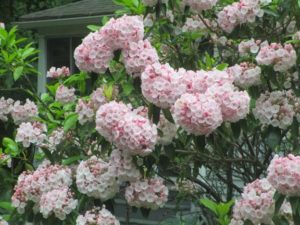
Mountain laurel, “Kalmia latifolia,” in bloom in the Pine Barrens around Helmetta, specifically the Jamesburg Park section of East Brunswick, Middlesex County.
MORE MOUNTAIN LAUREL LORE: I have mentioned here before the Pine Barrens lore I had heard, “The snapping turtle lays its eggs when mountain laurel blooms.” Here is some woods lore I just heard, “The deer would give birth around the time mountain laurel blooms.”
If you find a fawn, “Odocoileus virginianus,” seemingly by itself, leave it. Its mother is probably nearby, waiting for you to leave. If you come across a snapper, “Chelydra serpentine,” that needs to be moved from, say, a road, move it to safety in the direction it is traveling. It probably is a female, heading to uplands to lay eggs or returning to water after laying eggs. BE CAREFUL WITH SNAPPERS. More Piney lore, “Only the setting sun or lightning makes a snapping turtle let go.” I move them with a shovel, preferably a big grain shovel. Joey lore, “If a snapping turtle bites and will not let go, shove a wire in its nostril. Or maybe a flashing light will make it let go.”
Wild mountain laurel is virtually impossible to transplant.
Mountain laurel’s scientific name is “Kalmia latifolia.” The genus name comes from Pehr Kalm, a European botanist who worked in the South Jersey area in the 1700s. He published the influential “Travels into North America.” The plant’s species name is Latin for “broad-leaved.”
A SHORE GARDEN: On a newspaper reporting freelance story, I was at the home of artist Laura Petrovich-Cheney and her husband, educator and craftsman Peter Cheney, in Asbury Park, Monmouth County. Their property is on Deal Lake. There, a great egret, “Ardea alba”, and red-winged blackbird, “Agelaius phoeniceus,” flew along the lake. Purple martins, “Progne subis,” nest in houses on the property. In the gardens were various flowers in bloom: roses, poppies, daylilies (budding), peonies, yarrow, and trumpet vine honeysuckle. Also in gardens were Tears of Mary, tomato, eggplant, cucumbers, herbs, raspberry bushes, and a fig tree.
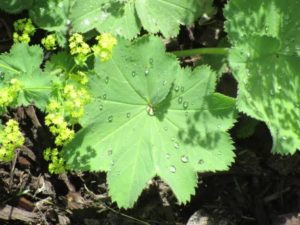
“Tears of Mary” plant in the Petrovich-Cheney and Cheney garden in Asbury Park, Monmouth County.
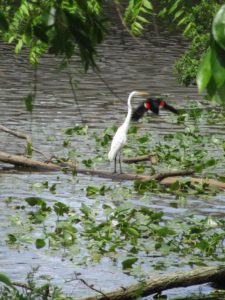
A red-winged blackbird flies past a great egret on Deal Lake at the Cheney and Petrovich-Cheney garden.
BIRD BATHS IN THE YARD: When my birdbath broke a few years ago, I took the bath part and laid it on the ground. When that had seen its days, I started using a garbage can lid, laying it on the ground. Now, I use large saucers – two in the backyard along the fruit and vegetable garden and one in the front yard. They are used by various animals: bird; squirrel; “Sciurus carolinensis”; and neighborhood cat, maybe even by skunk, “Mephitis mephitis”; chipmunk, “Tamias striatus”; raccoon, “Procyon lotor”; and ground hog, “Marmota monax.”
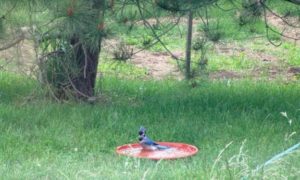
A blue jay, “Cyanocitta cristata,” in one of my backyard bird baths.
WATERING THE GARDEN: I water the garden before 10 a.m. so as not to lose water to evaporation in the heat of the day and so the garden dries by nightfall, preventing fungal growth. I use two watering methods – one, by sprinkling can if I have enough clean water accumulated (from rain, the cellar de-humidifier, and so on) and, two, by running a sprinkler. Sitting there with a cup of coffee and watching the sprinkler go back and forth is so relaxing. This week, a mourning dove, “Zenaida macroura,” joined me.
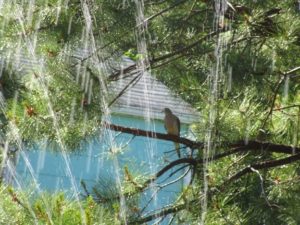
A mourning dove perches in a pitch pine – “Pinus rigida,” transplanted to my backyard from a Pine Barrens woods in Monmouth County – and hangs out with me as I watched the sprinkler water the garden.
BUTTERFLIES: As I have mentioned before, I am noticing a lot of tiger swallowtails, “Papilio glaucus,” the females black and the males yellow, this year. I usually cannot shoot a good photograph because they do not sit still. This week around my garden, I had a very cooperative female, allowing me to photograph away.
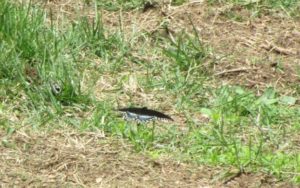
A female tiger swallowtail cruises over my garden.
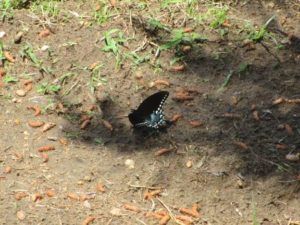
She rests in the garden.
DELAWARE RIVER AT FIELDSBORO: I was along the Delaware River near Fieldsboro, Burlington County. This is where the river transforms from commercial shipping (here and south) to recreational (here and north). Although the water here is fresh, there is a tidal effect as far north on the river as the area of Trenton, Mercer County.
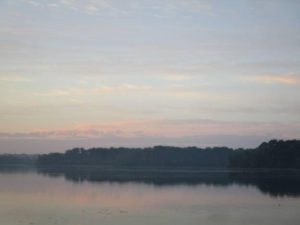
Dawn on the Delaware River, looking toward the area of Fieldsboro, Burlington County.
CLOUDS: Over the last several months, clouds have been spectacular. On the evening of May 31, Wednesday, I was along the Delaware River in the Fieldsboro area. It was clear where I was, but to the north were storm clouds with occasional streaks of lightning. The lightning was too sporadic for me to catch a photograph, but I shot pictures of the storm clouds and sunset. (Tip on photographing lightning: If the lightning is flashing near enough to one another, do not try to catch the flash. Instead, just keep on cranking pictures and hopefully there will be a usable shot of lighting in the batch – and hopefully you were not struck by lightning!)

Man in the cloud blows fire at a jet along the Delaware River.
LIGHTNING: A few years back, a Jersey Shore beachgoer at the Atlantic Ocean in clear weather was struck and killed by “out of the blue lightning” because, despite the clear weather at the beach, a thunderstorm was near enough. So, play it safe. The rule I follow, “If you hear thunder, you can be struck by lightning.” Seek cover.
NIGHT SKY: At dawn, look for the bright “star” in the East – the planet Venus. The Full Rose Moon is Friday, June 9. On Saturday, June 3, I stood on my back porch and looked at the moon, with the planet Jupiter just off it. I find it fascinating I can stand in my yard and look at the wonders of the night sky in the home I grew up in – and followed the USA-Soviet Union “Space Race” in the 1960s. Turn off the outside lights, let your eyes adjust for 20 minutes to 30 minutes, and enjoy a naked-eye view of the Night Sky.

The planet Jupiter aligned with the moon on the night of Saturday, June 3.
UNDER THE PORCH: After working an overnight shift, I came home to find a pile of dirt under one of my back porches, the one at the Florida room. Enough dirt in the pile to fill a wheelbarrow. I suspect a ground hog. I raked up the dirt and moved it to my garden, where I likely will rake it out in the fall. As for the animal hole, I let it be. Wildlife is welcome in my yard, but I prefer it does not mess with my vegetable-fruit garden.

The work of a ground hog, I presume.
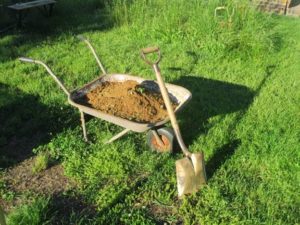
Off to the garden with the dirt. I can always find a use for it.
SUNRISE/SUNSET: For June 4, Sunday, to June 17, Saturday, the sun will rise about 5:30 a.m. and set about 8:25 p.m.
WEATHER: The National Weather Service forecasting station for the area is at http://www.weather.gov/phi/.
MY GARDEN: I continue with the three Ws – water, weed, and wait. The cool weather plants of lettuce and carrot are growing nicely, but the pea are lame. As for the warm weather plants, cucumber, mushmelon, and sweet corn, along with zinnia, are poking through the ground. No sign yet of tomato. (And I am thinking I may abandon planting tomato from seed. I am considering for next year buying plants and transplanting them into the garden.)
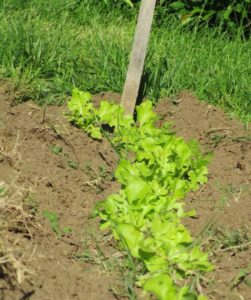
Salad Bowl Lettuce,” by Lake Valley Seed, growing in my garden.
UPCOMING “GARDEN AND AFIELDS”: After I publish a “Notes from Garden and Afield,” I panic, thinking, Will I be able to fill next week’s issue? Then, I realize there is plenty happening afield and in the garden. Alas, because of a scheduling conflict I have, “Notes from Garden and Afield” will not publish June 11. The plan is for it to return June 18. Meanwhile, check out on your own what is happening afield and in the garden.
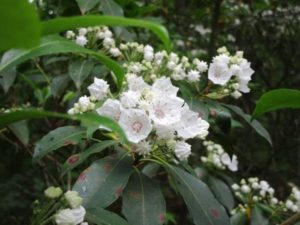
Mountain laurel, in bloom and about to bloom fully, in Jamesburg Park.
Joe Sapia, 60, is a lifelong Monroe resident. He is a Pine Barrens naturalist and an organic vegetable-fruit gardener.
He gardens the same backyard plot as did his Italian-American father, Joe Sr., and his Polish-immigrant, maternal grandmother, Annie Poznanski Onda. Both are inspirations for his food gardening. Joe is active with the Rutgers University Master Gardeners/Middlesex County program. He draws inspiration on the Pine Barrens around Helmetta from his mother, Sophie Onda Sapia, who lived her whole life in these Pines, and his Grandma Annie. Joe’s work also is at @JosephSapia on Twitter.com, along with Facebook.com on the Jersey Midlands page.
















































